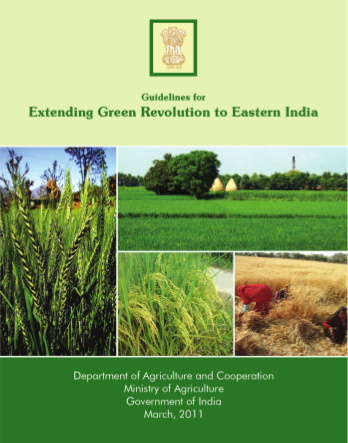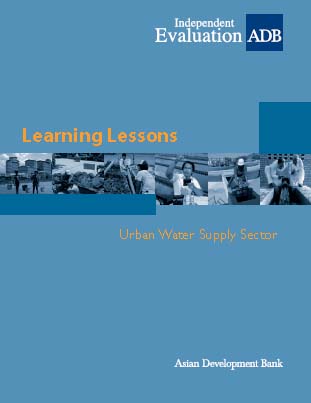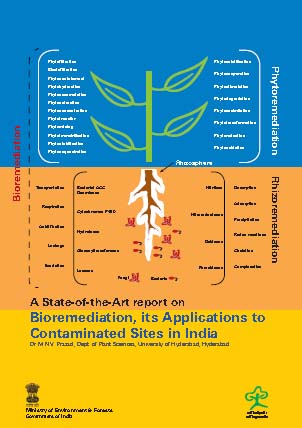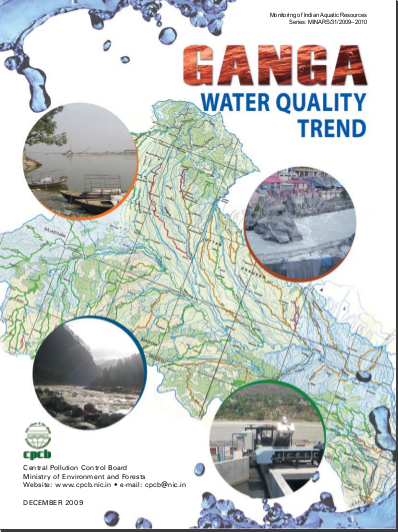/sub-categories/courses-toolkits-manuals-guides-and-handbooks
Courses, Toolkits, Manuals, Guides and Handbooks
Guidelines for extending green revolution to eastern India - Document prepared by Department for Agriculture and Cooperation (2011)
Posted on 27 May, 2011 07:50 AM The states of Assam, Bihar, eastern U.P, Chattisgarh, Jharkhand, Bengal, Orissa were allocated extra funds in the last year for this purpose.
The states of Assam, Bihar, eastern U.P, Chattisgarh, Jharkhand, Bengal, Orissa were allocated extra funds in the last year for this purpose.
Guidelines for rainfed area development programme - Document prepared by Department of Agriculture and Cooperation (2011)
Posted on 27 May, 2011 07:47 AMRainfed areas account for nearly 57 per cent of the agricultural land in India. These areas assume special significance in terms of ecology, agricultural productivity and livelihoods for millions. With proper management, rainfed areas have the potential of contributing a larger share to food grain production.
Guidelines for integrated development of 60,000 pulses villages in rainfed areas - Document prepared by Department of Agriculture and Cooperation (2011)
Posted on 27 May, 2011 07:36 AMThe budget allocates Rs 300 crores under the Rashtriya Krishi Vikas Yojana (RKVY) for this scheme. This project will supplement the ongoing work on pulses development under the National Food Security Mission. There is also an emphasis on building institutions that would provide market linkage to the grower of pulses. The states of M.P, U.P, Karnataka, Andhra Pradesh, Gujarat, Chattisgarh, Bihar, Maharashtra, Orissa, Rajasthan, and Tamilnadu were chosen for this programme. These states together constitute nearly 96% of area where pulses are grown.
Urban water supply sector – Key lessons and contextual sector risks – A note by Asian Development Bank
Posted on 22 May, 2011 08:56 PM The note complements ADB’s Guidance Note on Urban Water Supply Sector Risk Assessment and offers a framework for mapping governance risks to inform the preparation of future country partnership strategies.
The note complements ADB’s Guidance Note on Urban Water Supply Sector Risk Assessment and offers a framework for mapping governance risks to inform the preparation of future country partnership strategies.
Such a framework covers institutional aspects (policy, legal framework, and regulation); organizational aspects (planning, financial management, procurement, and human resources); and sector operations. While the note has identified entry points for mapping risks to development effectiveness in the sector, lessons from evaluations can augment ongoing efforts for mitigating these risks at institutional, organizational, operational, and project levels; and enhance the development effectiveness of ADB assistance in the sector.
Bioremediation, its applications to contaminated sites in India - A state of the art report by Ministry of Environment and Forests
Posted on 17 May, 2011 12:42 PM Bioremediation is emerging as an effective innovative technology for treatment of a wide variety of contaminants and is an invaluable tool box for wider application in the realm of environmental protection.
Bioremediation is emerging as an effective innovative technology for treatment of a wide variety of contaminants and is an invaluable tool box for wider application in the realm of environmental protection.
Bioremediation approach is currently applied to contain contaminants in soil, groundwater, surface water, and sediments including air. These technologies have become attractive alternatives to conventional clean-up technologies due to relatively low capital costs and their inherently aesthetic nature.
It includes phytoremediation (plants) and rhizoremediation (plant and microbe interaction). Rhizoremediation, which is the most evolved process of bioremediation, involves the removal of specific contaminants from contaminated sites by mutual interaction of plant roots and suitable microbial flora.
The report documents the existing knowledge for the benefit of regulators, who evaluate the quality of environment and for practitioners, who have to implement and evaluate remediation alternatives at a given contaminated site. It is expected to provide basic understanding of the bioremediation mechanisms to the reader. The technical descriptions provided in this document concentrate on the functioning mechanisms: phytosequestration, rhizodegradation, phytohydraulics, phytoextraction, phytodegradation, and phytovolatilization.
Agencies monitoring groundwater level in various parts of India in 2011 A list by the Central Ground Water Board
Posted on 16 May, 2011 07:26 PM
The CGWB has been monitoring groundwater levels on a quarterly basis during January, April/ May, August and November through a network of about 15000 observation wells located all over the country. This data is used for assessment of groundwater resources and changes in the regime consequent to various development and management activities.
Ecologically sound, economically viable community managed sustainable agriculture in Andhra Pradesh – A report by Society for Elimination of Rural Poverty and World Bank
Posted on 15 May, 2011 09:56 PM This report by Society for Elimination of Rural Poverty and World Bank deals with Community Managed Sustainable Agriculture (CMSA) in Andhra Pradesh. The paper also analyses the initial results of economic and environmental impact of CMSA, distills the key lessons learned from the Andhra Pradesh experience, and draws possible implications for future.
This report by Society for Elimination of Rural Poverty and World Bank deals with Community Managed Sustainable Agriculture (CMSA) in Andhra Pradesh. The paper also analyses the initial results of economic and environmental impact of CMSA, distills the key lessons learned from the Andhra Pradesh experience, and draws possible implications for future.
To address the adverse impacts of green revolution, the alternative approach to manage agriculture i.e., CMSA is being tested and practiced in the State. The CMSA approach replaces the use of chemical pesticides with a combination of physical and biological measures—including eco-friendly bio-pesticides—and complements it by adopting biological and agronomic soil fertility improvement measures leading to reduced use of chemical fertilizers.
Hydrological and farming system impacts of agricultural water management interventions for sustainable groundwater use in North Gujarat - A paper by Institute for Resource Analysis and Policy
Posted on 15 May, 2011 08:56 PMThe report by Institute for Resource Analysis and Policy (IRAP) and Society for Integrated Land and Water Management (SOFILWM) presents the findings of a research study undertaken in north Gujarat region, an area which has been undergoing significant changes in its farming systems as a result of several developmental interventions.
The study looked at a project initiated by IWMI and managed by SOFILWM in which water-efficient irrigation devices, water-efficient crops and land management practices were introduced among farmers in an effort to help them cut down groundwater use in irrigated agriculture without adversely affecting the economic prospects of farming.
Pampered views and parrot talks – In the cause of well irrigation in India – A paper by Institute for Resource Analysis and Policy
Posted on 15 May, 2011 06:14 PMIt is widely held that surface irrigation is becoming increasingly irrelevant in India’s irrigation landscape in spite of increased investments, and therefore future investments in irrigation should be diverted for well irrigation.
Ganga water quality trend - A report by Central Pollution Control Board (2009)
Posted on 30 Apr, 2011 05:39 PM The data has been collected over a period of many years from 39 water quality monitoring stations along the main river and 102 stations on its tributaries which were setup in 2008/09.
The data has been collected over a period of many years from 39 water quality monitoring stations along the main river and 102 stations on its tributaries which were setup in 2008/09.
The study focuses on the parameters for dissolved oxygen, (DO), biochemical oxygen demand (BOD) and faecal coliforms (FC) as these indicate the biological health of the river. The period of study for the river Ganga is 1999-2008. The study finds that most of the water quality parameters studied do not meet the standards.